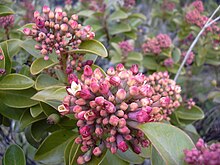Santalales
| Santalales | |
|---|---|
 |
|
| Santalum haleakalae | |
| Scientific classification | |
| Kingdom: | Plantae |
| Clade: | Angiosperms |
| Clade: | Eudicots |
| Clade: | Superasterids |
| Order: | Santalales |
| Families | |
|
See text |
|
See text
The Santalales are an order of flowering plants with a cosmopolitan distribution, but heavily concentrated in tropical and subtropical regions. It derives its name from its type genus Santalum (sandalwood). Mistletoe is the common name for a number of parasitic plants within the order.
Many of the members of the order are parasitic plants, mostly hemiparasites, able to produce sugars through photosynthesis, but tapping the stems or roots of other plants to obtain water and minerals; some (e.g. Arceuthobium) are obligate parasites, have low concentrations of chlorophyll within their shoots (1/5 to 1/10 of that found in their host’s foliage), and derive the majority of their sustenance from their hosts' vascular tissues (water, micro- and macronutrients, and sucrose).
Most have seeds without testae (seed coats), which is unusual for flowering plants.
The APG III system of 2009 (slightly changed from the APG II system of 2003 and the APG system of 1998) uses this circumscription:
The Angiosperm Phylogeny website indicates the Olacaceae (sensu APG II) are not a good family and should be split. Furthermore, it indicates disagreements about Santalaceae which need to include Viscaceae to be monophyletic (as is done in APG III). Studies based on DNA sequences also indicate the family Schoepfiaceae should be resurrected (as has been done in the updated APG III-publication) to accommodate Schoepfia (formerly in Olacaceae), Arjona and Quinchamalium (both previously in Santalaceae).
...
Wikipedia
